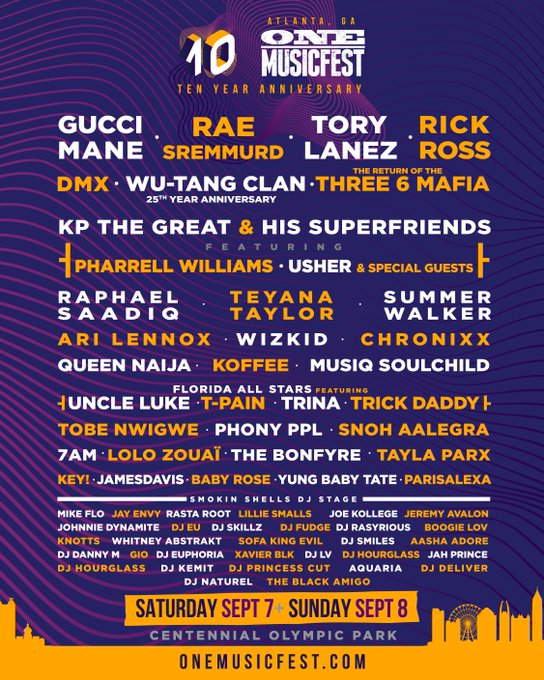I can attest for the Battery especially if you go game day. BTW checkout Fox's BBQ and try the brisket and good Terrapin beer.Dope thanks.
Def want to check out the civil rights museum and the aquarium. Early dinner at the sundial then head to the game?
Need to start planning. Thanks breh.
You are using an out of date browser. It may not display this or other websites correctly.
You should upgrade or use an alternative browser.
You should upgrade or use an alternative browser.
"The GOAT Black City" The Official: ATL Discussion Thread
- Thread starter FreshFromATL
- Start date
More options
Who Replied?staticshock
Veteran
staticshock
Veteran
ATV riders swarm busy streets in parts of metro Atlanta
ATV riders swarm busy streets in parts of metro Atlanta
ATLBikeLife got these cacs mad
ATV riders swarm busy streets in parts of metro Atlanta
ATLBikeLife got these cacs mad
Dusty Bake Activate
Fukk your corny debates
Yall city council need to do something about these fukking roads. Potholes and shyt everywhere. I been here 3 days and I feel like I’mma need new shocks and struts.
staticshock
Veteran
Yall city council need to do something about these fukking roads. Potholes and shyt everywhere. I been here 3 days and I feel like I’mma need new shocks and struts.
They do do something about them...metal plates

Pure Water
Veteran
Yall city council need to do something about these fukking roads. Potholes and shyt everywhere. I been here 3 days and I feel like I’mma need new shocks and struts.
Bruh. These shyts are fukking horrible. These shyt's South Carolina status.
I went to that a month and a half ago when I was there. It was coolWent to Cassette last night
So many ladies
Went with my wife tho
Pure Water
Veteran
Went to Cassette last night
So many ladies
Went with my wife tho
What's Cassette?
AVXL
Laughing at you n*ggaz like “ha ha ha”
Surprise! Atlanta, the nation’s capital of income inequality, has ranked high on a recently published list of the fastest-gentrifying cities in the U.S.
Between 2000 and 2014, Atlanta clocked in at No. 4, edged out for the dubious title only by Washington D.C., Portland, and Seattle, respectively, according to a report by the Federal Reserve Bank of Philadelphia and the University of Chicago.
The study, titled “The Effects of Gentrification on the Well-Being and Opportunity of Original Resident Adults and Children,” brings attention to the ills of gentrification, a socioeconomic phenomenon best known for displacing families of color from their homes.
The research, however, spotlights not just the pitfalls of gentrification, but the pros, too.
Federal Reserve Bank of Philadelphia:no_upscale()/cdn.vox-cdn.com/uploads/chorus_asset/file/18328382/Screenshot__333_.png)
While longtime residents watch rent prices and property values—and, subsequently, property taxes—spike, they also tend to witness poverty and crime rates drop, according to the report.
The report also states that boosting a city’s housing stock—with affordable housing or market-rate units—is a “promising way of maintaining and expanding housing affordability.”
Doing so, per the study, would “reduce out-migration pressure, and promote longterm affordability.”
To boost the supposed benefits of those policies, officials could impose rental subsidies and other inclusionary practices, such as implementing inclusionary zoning codes.
Also, via the report: “Targeting inclusionary policies to low-income families with children could encourage them to stay in neighborhoods improving around them, complementing existing programs...that seek to increase moves from low- to high-opportunity neighborhoods.”
In some local instances, the implications of gentrification have been overlooked or perhaps downplayed.
Developer Urban Creek Partners, for instance, caught a firestorm of flak recently, after officials had released marketing materials for the upcoming mixed-use build Quarry Yards that many complained were insensitive.
Journalists and observers alike noticed a lack of people of color in content shared about the project on social media, which advertised a “New Atlanta”—a nickname many found represented the change in racial demographics that could result from upscale new development.
City of Atlanta:no_upscale()/cdn.vox-cdn.com/uploads/chorus_asset/file/18328387/Screenshot__331_.png)
Bankhead, after all, is a historically black neighborhood well-known in part due to nods from hip-hop songs by Atlanta legends such as T.I., who’s undertaken development ambitions of his own in the area.
Harris is now trying his hand as a real estate developer, aiming to revitalize his Westside hometown Center Hill, a neighborhood just southeast of Bankhead.
Bankhead is staring down the barrel of serious gentrification.
City of Atlanta research depicting “neighborhood gentrification pressure areas” determined that Bankhead was in the “dynamic stage” of gentrification, meaning it was under “high-pressure” of gentrifying forces.
The research shows the areas yet untouched by gentrification or in the “susceptible stage” are largely focused in Southwest Atlanta, whereas those in the “mature stage” are mostly found in the north and northeast parts of town
Pure Water
Veteran
What's Cassette?
So y’all nikkas ain’t gone answer my question huh?
Pure Water
Veteran
They need to gentrify these roads.




